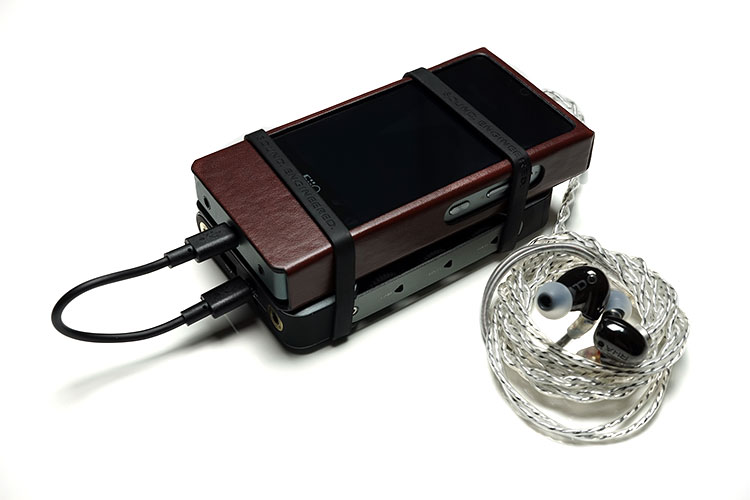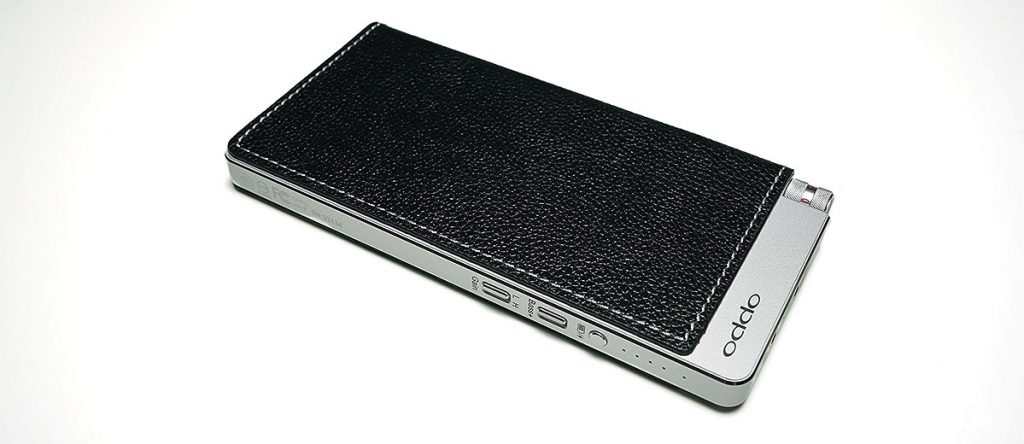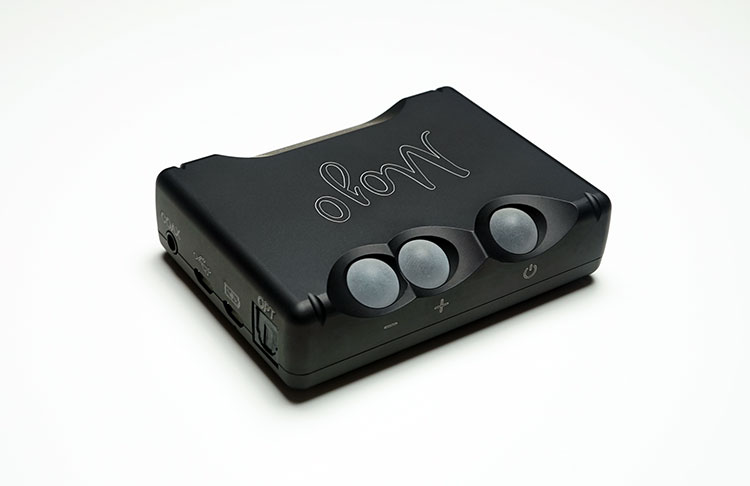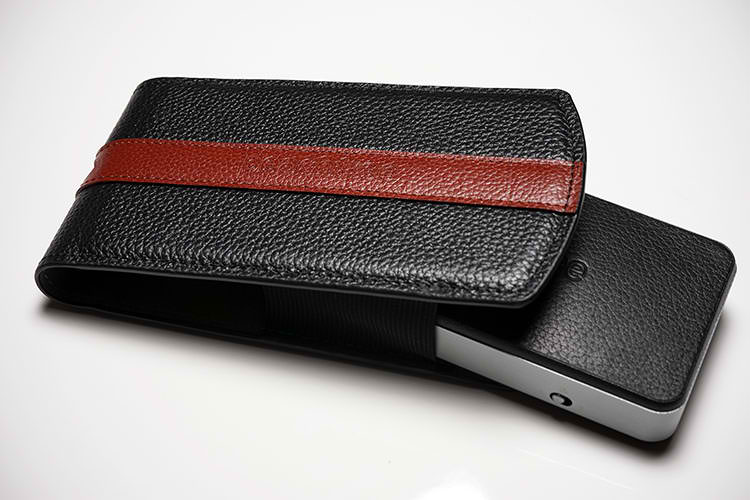Dacamp L1 Sound Impressions
Tonality & Presentation
Well-Tuned Treble
Tonally the Dacamp L1 is relatively neutral, quick, and precise in its presentation. The ES9018K2M DAC chip really shines through with excellent detail right across the range but what pleases me the most is the way this has been engineered with the amp stage of the L1. It never comes across as sterile or thin sounding and more importantly, it shows no harsh or brittle treble traits. The top-end extension and articulation is there but nothing overly forced. This is a nicely tuned SS amp for treble.
Impactful Bass
Bass on the Dacamp L1 is more linear than boosted but it remains impactful with a slight hint of warmth and an ever so slightly slower decay. It extends fairly well but it is more tactile and well defined in its response than omnipresent throughout. I tend to find these presentations to be more natural sounding and accurate than bass-heavy or darker amps such as Kojo Km-01 brass amp or the budget FiiO A5.
Spacious & Clean
It is also a very spacious sounding amp with excellent width and good depth to its soundstage. There is the slightest bit of roll-off at both ends but nothing terribly noticeable. Imaging and instrumental separation are accurate and with a clean attack and good body. The noise control is excellent also with a black background which really benefits more sensitive headgear and makes it an ideal amp for large-scale orchestral works or ambient genres.
Treble/Bass/Gain Tweaking
Of course, you have options to tweak the sound using the Dacamp L1’s treble and bass options. How much or how little you want to use them will ultimately depend on your tonal preference, the source, and head gear you are using. Generally speaking about +2 or negative 2 on other dials was enough before it sounded too brittle in its treble or overly bloated on the low end.
CL1
For instance, using the USB-DAC and its WASAPI drivers with the CL1 I found little need for the treble and bass tweaks. Dipping the treble dial to say -1 or -2 took a little something away from the vocal presence. It simply did not sound as open when the dial is set to zero. Anything about +2 though is too sharp and peaky and leaves the CL1 relatively unbalanced.
Dialing down to about -2 on the bass took a little bit of body out of the CL1’s warm and boosted bass response so for those who like a flatter response this could be an ideal presentation. I would hesitate though going over +2 on the bass dial as it tended to get a bit overpowering and overly warm.
Headphones
Similarly, on headphones such as the AKG K872 and K501 as well as the HD700 I only had to make minor adjustments using the bass and treble dials to get a good balance or counteract the weaknesses of the pairings for better synergy. Beyond +/- 2 or 3 and things started to sound very uneven.
Balanced
You can only really use balanced with the Dacamp L1 out of the box unless you start getting into DIY projects with cables on other IEMs. However, it is a great pairing, the best of all the matches with the CL1 and a step up from the unbalanced output of the Dacamp L1.
I really get a feeling that the CL1 is getting some decent power and running at optimal levels. This means a smoother attack, a shorter decay, and a more natural lower treble performance than the unbalanced output. With the right track playlist, I could actually listen to this pairing all night. Line up some Cocteau Twins, Straits, Pink Floyd, and Fiona Joy and I am right at home.
It’s still an elevated and forward IEM so do not expect syrupy good times with the Dacamp L1 but it does feel more coherent without the additional hardware EQ required and generally lends itself a bit more to a wider selection of genres.
Matchability
Digital Input
The Dacamp L1 can receive either a line-level input or a digital input directly from a smartphone or USB DAC output from a PC. If you want the most efficient and best way to control noise and have a smooth volume control with plenty of wiggle room for efficient IEMs then I recommend going via the digital route and using the L1’s own decoding prowess over the analog amp-only setup.
OTG
With the digital control on OTG, for instance, you can set the volume on both the phone and the L1 amp giving you plenty of micro-control over the L1 voltage levels. Using RHA’s own CL1 in combination with the ZTE Axon 7, for instance, allowed me complete control of steps 1 to 5 in low gain by simply adjusting the output level via USB on my smartphone.
With super-efficient IEM’s such as the CA Andromeda, I can drop the USB digital control on my smartphone right down to negligible levels freeing up steps 1-3 on the RHA pot which is decent enough levels of volume control for such a sensitive IEM.
USB DAC
The Dacamp L1 is supremely confident operating as a USB-DAC out from a laptop or PC. Technically software such as Foobar can be used as a pre-amp to the Dacamp L1 so you can really fine-tune the L1 volume for whatever headphone or IEM you are using. You will, of course, need to download drivers for Windows to recognize the L1 but it is a straight forward process. For MAC users it is plug and play.
Analog Input
Unfortunately, the Dacamp L1 is not as flexible with IEMs in terms of voltage control using a fixed line-level output from DAPs and other devices. The L1 low gain base db setting is a bit too high to get any series wiggle room on the attenuator before 1-2 steps. For example, if you stay one-stop below 2 on the pot with the 12.8-ohm Campfire Audio Andromeda it sounds great, but move it one notch to 2 the voltage level overpowers the Andromeda and similar IEMs such as the 8-ohm SE846 and CA’s 14-ohm Orion.
For dynamic IEMs the results were largely similar. The relatively inefficient budget M4 by Advanced which is a 16 ohm 92dB driver I could not actually get any audible signal until 1 step below 2 then suddenly it is too loud at the next step. Even for power-friendly IEMs such as CA’s dynamic driver 17.5 ohm Vega, the gain jump at around level 2 is too steep for micro-control.
RHA CL1 & CL750
With RHA’s own IEMs, the CL750 and CL1 the scenario is different and much more manageable. With the CL1, which is 150 ohm and 89dB I am hitting optimal voltage levels around one stop below 3. Also, the volume curve from 2-3 is smoother and not as abrupt as with other IEMs tested so you will not get a short sharp shock if you go a little higher than intended. Definitely, the L1’s IEM performance on a line-level input is better optimized for RHA’s own IEM’s in terms of power handling and efficiency.
Headphones
Efficient Planars
Analog fixed line-level input is, however, excellent for a wide range of headphone pairings. The L1 has no problems driving efficient planars headphones such as the Hifiman Edition X V2 and the Oppo PM series. Both of these sit almost at the same volume level as the CL1 which is somewhere between 2 and the final step before 3 on the L1 pot. Tonally the Edition V2 pairing is vivid, musical and energetic and one of my favorite out of all the headphones tested.
Dynamic Headphones
Higher rated or less efficient dynamic headphones such as the AKG K872, HD700, and my old K501 also drove easily out of the L1 though tonally the HD700 pairing didn’t excite me as much as the Edition X V2 with an edgier top end that strayed into sibilance and peakiness a little too much with the L1. I found toning down the treble via the EQ dial to around -2 on the HD700 to produce a much smoother pairing.
The AKG K501 was a little thin also for my liking but it does like a lot of power over gain to really get the low end moving so that is not surprising. For the K501 I preferred treble at -3 and bass at +2 on the EQ dials. With this setting, I got a bit more body and mid-bass impact and a smoother treble response.
The K872 was excellent with the L1 with bass set at +2 and treble at -1. The K872 for me has a natural-sounding presentation for a closed headphone with excellent detail and it is fairly easy to drive. You do not get a huge amount of control at line level with the K872 given its sensitivity rating but its noise-free, impactful and energetic with the L1 pairing. Volume control is even better if you pair using OTG and tone down the volume on the source side.
Noise Control
The L1 is an excellent performer for noise using both the analog line-level input and the digital inputs for IEMs and headphones. With zero background hiss on all IEMs tested it is perhaps one of the best in the market today at this price point outside of the Mojo.
Even the notoriously noise aware Andromeda projected a perfectly black background with what volume I could use safely. Normally Campfire Audio’s all-BA designs show up noise right away, even on DAP’s but not in the case of the L1.
Select Comparisons
Oppo HA-2SE
$299
Technicalities
The HA-2Se is the revised edition of the older HA-2 from Oppo yet it retains the same price as the previous generation. The latest version now includes the newest Sabre chip release, the ES9028 so it is slightly ahead of the L1 in terms of DAC technology but it is a single chip implementation compared to the L1 dual ES9018K21M implementation.
Efficiency
The benefits of differential DAC designs can be clearly heard in the L1 with a much quieter and blacker background than the HA-2SE. On sensitive IEMs you do get more voltage control on the HA-2SE, and I do prefer its pot control in general but at really low levels of volume, the noise floor is higher. It is clearly a big improvement on the noisy HA-2 but not at the level of the L1. Like the L12 the HA-2SE has some gain and bass control but it is more fixed than the more flexible dial system of the L1.
Tonality
Tonally the HA-2SE is slightly flatter sounding across the range than the more dynamic L1. However, I am impressed with the new 9028 chip inside it as it actually stays very clean and clear but has a slightly softer edge up top than the L1. In comparison, the L1 is every bit as detailed, more dynamic with a fuller low end and a more forward and vivid mid and vocal but the top end is harder sounding.
Some will interpret the L1 as having a sharper attack over the HA-2SE and to some extent I agree. In contrast, the better dynamics, bass, and treble tweaking control, as well as the blacker background of the L1, will make this a more fun-sounding signature than the HA-2SE reference-like response. I dig the energy of the L1 for modern pop and rock than the HA-2SE but I like the HA-2SE a lot for the way it takes the edge off the attack.
Chord Mojo
$599
Technicalities
The Mojo is the audiophile darling of 2016 and still going strong today in 2017. Chord just announced a bunch of add on’s including the poly which should greatly extend its feature set but of course also increase the cost of entry to almost $1k. It pretty much caters to a similar audience as the L1 with a wide appeal to both IEM and headphone users right up to 600 ohms.
Sampling and decoding prowess between the both of them is good, they cover almost all of the codec range though the Mojo can go that bit higher at 768kHz PCM compared to the L1 384kHz PCM. In real-world terms though both have all the commercial sampling rates covered.
The Mojo also has a much shorter battery life at just 8 hours as well as an odd form factor which makes it a little bit challenging to stack. Both, however, are built like tanks. You could play a game of conkers with both of them and I am not sure which one would win.
Efficiency
Like the Dacamp L1, the Mojo is also deathly silent with a really low noise floor on sensitive gear but it has the edge in power up to 600 ohms as well as having better voltage control for low-level microvolume adjustment on IEMs. What it does not have that the L1 has is a plethora of analog input and outputs at the line-level. The Mojo is strictly limited to digital input from either USB or Coaxial.
Tonality
Tonally both have a similar impactful full-sounding low end and excellent mid-range detail but the Mojo has the slightly softer, more balanced top end but still retaining excellent extension, articulation, and detail.
By contrast, the L1 has a slightly bigger staging quality to its presentation, a more dynamic and aggressive low end but as you move further up it has a slightly thinner note starting in the upper mids and into the treble. It has more energy, perhaps more sparkle but it is a little sharper sounding and maybe slightly the more difficult of the two to pair with a wider range of headgear.
Voltage control on the Mojo is also superior with a far better low end-setting for IEMs than the L1 though the whole orb color scheme still confuses me at times and I do wish it would revert back to zero when it starts up.
Peachtree Shift
$329
Technicalities
Peachtree launched the Shift mid-2016 and it takes a similar form factor to the HA-2SE only its dimensions are a bit bigger and has that slightly awkward raised leather top that makes it a bit off balance for stacking. It also uses an ES chip but one down from the ES9018k2m, instead of using a single ES9010k2m DAC chip.
Decoding rates, however, are pretty strong all the way up to and including 32-bit/384kHz PCM and 5.6MHz Direct Stream Digital (aka double-rate DSD or DSD128). It will not do DSD256 though unlike the L1 and Mojo.
Like the Mojo though it is missing a few features that the L1 has, namely analog line-level inputs and also an onboard volume pot, preferring instead to shift duties over to the transport or original source. This seems perfectly fine since the Shift only has digital inputs for USB-DAC, OTG, and iOS lightning compatibility but those wishing to use a 3.5mm line out from any source will be left wanting.
The Shift also has a power bank feature much like the L1 but battery life overall is a bit shorter at just 8 hours despite having the larger 4800mAh battery.
Efficiency
Power-wise the Shift has the edge over the L1 with a 65mW into 600-ohms rating compared to the L1’s 28mW into 300 ohms but the noise level on the L1 is superior on efficient IEMs with a blacker background. The shift will drive headphones though a bit better than the L1 but tonally it sounds a bit off on efficient IEMs.
Tonality
Peachtree has done a lot of fine-tuning on the ES9018 to avoid glare as well as produce a virtually silent background on efficient gear. It is also a bit different sounding compared to the L1 though both use Sabre chips. Tonally, the Shift offers a warm to neutral musical presentation with a smooth sounding and an almost analog-type feel rather than a cold digital response.
However, the Shift sounds a little compressed and less spacious sounding on IEMs with a softer attack than the more open and detailed L1. My feeling was that the Shift’s top end is pulled down a notch also to compensate whereas the L1 has the better extension in either direction and a fuller sound.
Dynamics though are a step up on the L1 compared to the Shift with a punchier tighter low end, a more vivid and engaging mid-range, and vocal performance. The L1 is also better with detail than the Shift, particularly in the mids. If you prefer a slightly easier going softer sound the Shift will match perfectly well with the likes of the CL1 but I prefer the more dynamic and open sound of the L1.
Our Verdict
Tonal Excellence
The Dacamp L1 is an impressive first effort from RHA. Tonally it hits all the right notes and for an ESS chip, it is very well-tuned delivering an impactful yet linear and clean presentation that makes it flexible to pair with most IEMs and headphones. Most impressively noise control is top-notch with next to no background hiss on anything tested from the most efficient IEM to regular headphones. It is also built like a tank, doubles up as a useful power bank for portable devices, and has plenty of connectivity options for modern lifestyles.
Caveats
There are some caveats though with the RHA Dacamp L1. Voltage control is too aggressive for efficient IEMs and headphones with fixed-line levels leaving little room for volume control for efficient headgear. You cannot use the balanced output either when using its line-in which is a shame as it rules out using the CL1 in balanced mode with regular line-level analog inputs. OTG and USB-DAC connectivity will give you more control on the source side and it does seem this is where the L1 is at its most confident.
CL1 Bliss
The RHA Dacamp L1 is optimized for the CL1, this is very clear in terms of tonality, voltage control, and the purposed use of the mini-XLR socket for balanced connections. Much like the CL1 in terms of appeal, the L1 is not going to be everyone’s cup of tea, but pair them together and they do sound very good indeed.
Dacamp L1 Technical Specifications
| Output power (16Ω) | 300mW |
| Output power (300Ω) | 28mW |
| Output impedance | 2.2 ohms |
| THD+N | >0.0018% |
| Dynamic range | 111dB |
| PCM sampling frequencies | 44.1 – 384kHz, 16 / 24 / 32-bit |
| DSD sampling frequencies | 2.8224MHz (DSD64), 5.6448MHz (DSD128), 11.2896MHz (DSD256) |
| Input connections | 3.5mm line-in, USB A, USB micro-B, mini-TOSLINK Optical |
| Output connections | 3.5mm line out, 3.5mm headphone out, 4-pin Mini XLR (balanced) |
| Battery | 4000 mAh |
| Dimensions | 118x73x20mm |
| Weight | 233g |









